| Back Number | No.25 2005/09/28 | |||
| News | EXPO 2005 Closing Ceremony Winners of the 2nd Nature’s Wisdom Award Announced |
 |
||
| Column | Reuse of the EXPO 2005 Venue: Toward Development for Eco-Communities | |||
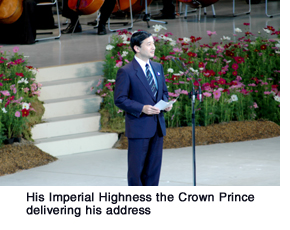 The first world exposition of the 21st century, EXPO 2005 Aichi, Japan, which was held for 185 days under the theme “Nature’s Wisdom,” closed at 10:00pm on September 25. The EXPO’s closing ceremony was held in the afternoon at EXPO Dome, in the Nagakute Area, with the participation of about 2,250 people. His Imperial Highness the Crown Prince, Honorary President of EXPO 2005, as well as Prime Minister Junichiro Koizumi, Honorary Chairman of EXPO 2005, attended the ceremonies. Many visitors viewed the ceremony that was broadcast at EXPO 2005 on screens at EXPO Plaza in the Nagakute Area and the Civic Theater at the Civic Pavilion in the Seto Area.
The first world exposition of the 21st century, EXPO 2005 Aichi, Japan, which was held for 185 days under the theme “Nature’s Wisdom,” closed at 10:00pm on September 25. The EXPO’s closing ceremony was held in the afternoon at EXPO Dome, in the Nagakute Area, with the participation of about 2,250 people. His Imperial Highness the Crown Prince, Honorary President of EXPO 2005, as well as Prime Minister Junichiro Koizumi, Honorary Chairman of EXPO 2005, attended the ceremonies. Many visitors viewed the ceremony that was broadcast at EXPO 2005 on screens at EXPO Plaza in the Nagakute Area and the Civic Theater at the Civic Pavilion in the Seto Area.While rape blossoms of spring filled EXPO Dome for the opening ceremony held on March 25, a multitude of autumn cosmos blooms adorned the closing ceremony held six months later. Adding flower to the closing ceremony was a 3,000-meter-long colorful piece of cloth, woven by visitors to EXPO 2005 during this world exposition, which decorated the back of the stage. The closing ceremony was a two-part event consisting of the ceremony and a Message Event. The ceremony, which was opened by Toshio Nakamura, Secretary-General of the Japan Association for the 2005 World Exposition, began with an address by Shoichiro Toyoda, Chairman of the association. Masaaki Kanda, Governor of Aichi Prefecture, then gave words of appreciation, followed by words of greeting by Prime Minister Koizumi and Wu Jianmin, President of the International Exhibitions Bureau (Bureau International des Expositions: BIE). His Imperial Highness the Crown Prince gave an address in which he said, “I sincerely hope that the sensations experienced by the myriads of people who visited the Exposition will spread throughout the world to become an immense movement to overcome the many serious issues that face the people of the world today.” Prime Minister Koizumi said, in his speech, “It is my deepest wish that EXPO 2005 Aichi will help to spread the concept of ’mottainai’ around the world, and that by not wasting what is valuable, we will be able to realize a society in which humankind and nature can live in harmony.” |
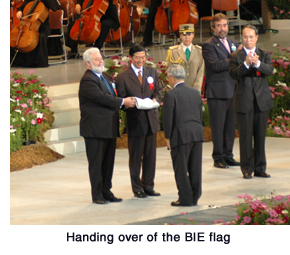 The BIE flag was subsequently handed over to Wu Jianmin, President of the BIE, and Secretary-General Vincente Gonzalez Loscertales by Chairman Toyoda of the Japan Association for the 2005 World Exposition, and the two firmly handed the flag on to Zhou Yupeng, mayor of Shanghai, China where the next world exposition will be held in 2010. A BIE flag was also handed to Juan Alberto Belloch, Mayor of Zaragoza, Spain, where an international recognized exhibition (EXPO 2008) is newly scheduled to be held in 2008.
The BIE flag was subsequently handed over to Wu Jianmin, President of the BIE, and Secretary-General Vincente Gonzalez Loscertales by Chairman Toyoda of the Japan Association for the 2005 World Exposition, and the two firmly handed the flag on to Zhou Yupeng, mayor of Shanghai, China where the next world exposition will be held in 2010. A BIE flag was also handed to Juan Alberto Belloch, Mayor of Zaragoza, Spain, where an international recognized exhibition (EXPO 2008) is newly scheduled to be held in 2008.The MCs of the Message Event, which followed the ceremonies, were Keiko Takeshita, actress and chief pavilion director of the Japan Pavilions, singer Aya Matsuura and child-actor Ryunosuke Kamiki. They played a role of a family in the proceedings. First, EXPO 2005 mascots Morizo and Kiccoro, performance team Sol Ban Ban (of the 185 Performance Circuit) and other popular EXPO 2005 characters appeared and gave a gay performance. Later, the three MCs looked back on EXPO 2005 through Ryunosuke’s picture diary (he is an elementary school student) filled with fun memories regarding the pavilions he had visited and footage of stage performances by artists of various countries that Aya, playing the role of his sister, was moved by. When the last page of Ryunosuke’s diary, which was concluded regretfully by the words, “The EXPO that I enjoyed ended on Sunday, September 25,” was turned, two children of the future appeared midair at the back of the stage. While congratulating the successful conclusion of EXPO 2005, they called upon the audience to, “Please promise us that the value of EXPO 2005 and the future of the Earth will be shaped together by humankind from here, from today, for us and for all life.” |
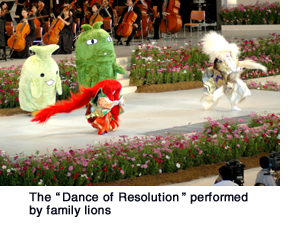 In response to this message, the various results of EXPO 2005 were shown as footage entitled “Response to the Future.” The film that introduced some of the activities of the 235 citizen’s groups at EXPO 2005 Aichi, Japan, the first world exposition to be held with civic participation, gave audiences a sense of the possibilities of the building of a future together by citizens, corporations and governments. Furthermore, the various endeavors towards new energy, such as the solar energy and fuel cells that supplied the EXPO with power every day, proved the possibilities of advanced technology in supporting the development of a sustainable future. And, the Eco-Money Project in which points were awarded to people for environmentally responsible behavior, was promoted as an experimental project for an environmental currency that was friendly to people, the environment and the Earth. Citizens, corporations and governments became one, and there were more than a few visitors who experienced the challenges and joy of individual consideration for the environment and expanding the network of such action. Seeds for the realization of a society that is friendly to people and the Earth were also planted at EXPO 2005.
In response to this message, the various results of EXPO 2005 were shown as footage entitled “Response to the Future.” The film that introduced some of the activities of the 235 citizen’s groups at EXPO 2005 Aichi, Japan, the first world exposition to be held with civic participation, gave audiences a sense of the possibilities of the building of a future together by citizens, corporations and governments. Furthermore, the various endeavors towards new energy, such as the solar energy and fuel cells that supplied the EXPO with power every day, proved the possibilities of advanced technology in supporting the development of a sustainable future. And, the Eco-Money Project in which points were awarded to people for environmentally responsible behavior, was promoted as an experimental project for an environmental currency that was friendly to people, the environment and the Earth. Citizens, corporations and governments became one, and there were more than a few visitors who experienced the challenges and joy of individual consideration for the environment and expanding the network of such action. Seeds for the realization of a society that is friendly to people and the Earth were also planted at EXPO 2005. |
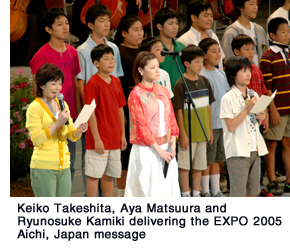 Towards the end of the Message Event, an old man and a lion and cub spirit that live in the same forest as Morizo and Kiccoro appeared on stage. The lion and cub danced the “Dance of Resolution,” in which what was obtained through EXPO 2005 was passed on from the parent lion to the cub. This was another “Response to the Future.”
Towards the end of the Message Event, an old man and a lion and cub spirit that live in the same forest as Morizo and Kiccoro appeared on stage. The lion and cub danced the “Dance of Resolution,” in which what was obtained through EXPO 2005 was passed on from the parent lion to the cub. This was another “Response to the Future.”In the Finale, the flags of the 121 countries and four international organizations which participated in EXPO 2005, small country flags being waved by the children of 71 municipal governments that participated in the Aichi International Campaign for Hometown Interchange and Hospitality (AICHI Hospitality) program, and attendants of each pavilion entered the stage one after another, filling the venue with colorful excitement. |
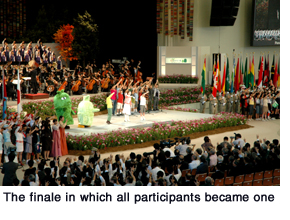 At this time, the “family” of three presented the EXPO 2005
Aichi, Japan Message. Ryunosuke, playing the role of the child, said “A
seed has sprouted. There is yet no flower or fruit. It is still but a
small bud.” Keiko Takeshita, as the mother, said, “We want
to believe that the 185 days were for blossoming a flower and fruit of
the future,” ending by saying, “Let us all begin passing on
our actions, regardless of the age. Everything is beginning now, from
here.” Finally, the beautiful voice of Aya Matsuura filled the stage
as she sang, “Friends Love Believing EXPO 2005,” with the
Nagoya Children’s Choir joining in partway. At the proposal of Ryunosuke,
who said, “Let us all make the gesture that the children of the
future taught us,” all those gathered at the closing raised their
right little finger, big finger and index finger to make the universal
sign language for “I love you.” They waved their hands high
in the air as they sent a message to the world of a pledge to the children
of the future. At this moment, the entire venue became one.
At this time, the “family” of three presented the EXPO 2005
Aichi, Japan Message. Ryunosuke, playing the role of the child, said “A
seed has sprouted. There is yet no flower or fruit. It is still but a
small bud.” Keiko Takeshita, as the mother, said, “We want
to believe that the 185 days were for blossoming a flower and fruit of
the future,” ending by saying, “Let us all begin passing on
our actions, regardless of the age. Everything is beginning now, from
here.” Finally, the beautiful voice of Aya Matsuura filled the stage
as she sang, “Friends Love Believing EXPO 2005,” with the
Nagoya Children’s Choir joining in partway. At the proposal of Ryunosuke,
who said, “Let us all make the gesture that the children of the
future taught us,” all those gathered at the closing raised their
right little finger, big finger and index finger to make the universal
sign language for “I love you.” They waved their hands high
in the air as they sent a message to the world of a pledge to the children
of the future. At this moment, the entire venue became one. |
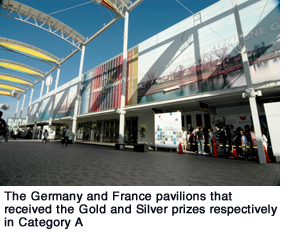 Following the 1st Nature’s Wisdom Award announced on May 26, the Japan Association for the 2005 World Exposition announced, on September 19, the outcome of the jury examination for the 2nd Nature’s Wisdom Award to which the pavilions of the 120 official participating countries and international organizations (the Japan pavilions excepted) exhibiting at EXPO 2005 Aichi, Japan were object.
Following the 1st Nature’s Wisdom Award announced on May 26, the Japan Association for the 2005 World Exposition announced, on September 19, the outcome of the jury examination for the 2nd Nature’s Wisdom Award to which the pavilions of the 120 official participating countries and international organizations (the Japan pavilions excepted) exhibiting at EXPO 2005 Aichi, Japan were object.Evaluations were made, as in the 1st Award, by nine Japanese and overseas influential individuals commissioned by the Japan Association for the 2005 World Exhibition to serve as members of the jury. Upon making an onsite evaluation of all eligible pavilions, the jury selected winners of three prizes (Gold, Silver and Bronze) for each of the four categories that pavilions were placed in according to its scale. The Germany Pavilion was awarded the Gold Prize in Category A, having been highly recognized “For its superb presentation concerning problems confronting the planet and for its innovative efforts to educate the public about possible solutions based on learning concrete examples from nature.” The winners of the Gold Prize in categories B, C and D were the Mexico Pavilion, The Netherlands Pavilion, and the Andean Amazonian Pavilion respectively. |
||||||||||||||||||||||||||||||||||||||||
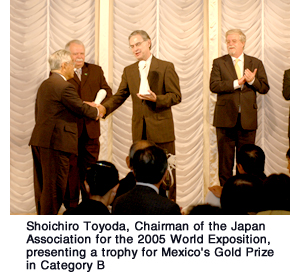 The 1st Nature’s Wisdom Award evaluated such criteria as the quality of the interior and exterior décor, the quality of the exhibits and the relevance of the physical displays to the theme, functionality and cleanliness. This 2nd award evaluated the messages being communicated to the world by participants under the Nature’s Wisdom theme in order to solve today’s global issues related to nature conservation, to highlight the value of biodiversity and cultural diversity, and to promote mutual understanding and international exchange.
The 1st Nature’s Wisdom Award evaluated such criteria as the quality of the interior and exterior décor, the quality of the exhibits and the relevance of the physical displays to the theme, functionality and cleanliness. This 2nd award evaluated the messages being communicated to the world by participants under the Nature’s Wisdom theme in order to solve today’s global issues related to nature conservation, to highlight the value of biodiversity and cultural diversity, and to promote mutual understanding and international exchange.The pavilions which received prizes are as follows: |
||||||||||||||||||||||||||||||||||||||||
|
||||||||||||||||||||||||||||||||||||||||
| The award ceremony for the 2nd Nature’s Wisdom Award was held, together with that for the 1st Nature’s Wisdom Award announced on May 26, at a reception hosted by the International Exhibitions Bureau (Bureau International des Expositions: BIE) on September 24, which was BIE Special Day. | ||||||||||||||||||||||||||||||||||||||||
![]()
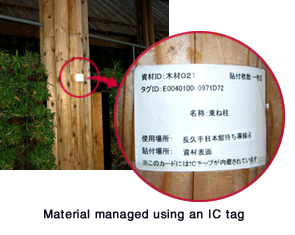 EXPO 2005 Aichi, Japan closed on September 25, and the dismantling and removal of the venue that drew approximately 22.05 million visitors is already in progress.
EXPO 2005 Aichi, Japan closed on September 25, and the dismantling and removal of the venue that drew approximately 22.05 million visitors is already in progress.A sub-theme of EXPO 2005 was “Development for Eco-Communities.” The EXPO declared the proactive introduction of the 3Rs (Reduce, Reuse and Recycle) as one of the efforts for environmental consideration. In fact, the construction of the EXPO venue was advanced with the 3Rs - to reduce, reuse and recycle waste - in mind. Even among the 3Rs, the environmental load of “reuse” is dramatically lower than “recycle” since it does not necessitate the use of the energy that is required for recycling. However, while the recycling of some building materials, such as concrete blocks, is progressing when structures are dismantled, the truth is that the same cannot be said in the reuse of such materials. In this issue, let us take a look at the various endeavors being undertaken for reuse at EXPO 2005 upon dismantling and removal. On September 16, the Japan Pavilion launched the “Re-use Nippon-kan” website with the purpose of promoting the reuse of materials that arise as a result of dismantling the structure, exhibits, and so on at Japan Pavilion Nagakute and Japan Pavilion Seto. Lists of materials and equipment that are the object of reuse have been published on this site under five categories: Construction Materials; Electrical Equipment; Air-Conditioning and Sanitation; Displays and Other; and Elevating Machines. Interested parties can participate, by post, in bidding for the desired item. Furthermore, the Japan Pavilion is scheduled to hold, on October 2nd and 3rd, tours for the general public and for organizations and businesses to inspect the materials for reuse. The reuse of the materials of the Japan pavilions is possible because the pavilions were constructed on the premise that they would be reused upon dismantling and removal. For example, information regarding materials was managed by attaching IC tags (also known as Radio Frequency Identification (RFID) tags, or memory chips used for identifying objects) in advance to some of the materials subject to reuse in order to enable the retrieval of information necessary to assess residual value (value after use) at the time of reuse. In other words, the Japan pavilions were proving tests for the promotion of “reuse.” |
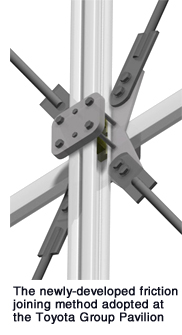 Endeavors towards reuse were implemented at other pavilions as well. For example, the Toyota Group Pavilion was constructed under the premise of achieving zero waste-that is to thoroughly sort and recover all construction materials upon dismantling so that they could be reused or recycled. One way was the method used to join steel frames. Because the existence of bolt holes makes it difficult to reuse steel frames in other structures, a newly-developed friction joining method that allowed for minimum hole-drilling was adopted. It consists of two metal parts tightly secured by bolts to sandwich and support the frame.
Endeavors towards reuse were implemented at other pavilions as well. For example, the Toyota Group Pavilion was constructed under the premise of achieving zero waste-that is to thoroughly sort and recover all construction materials upon dismantling so that they could be reused or recycled. One way was the method used to join steel frames. Because the existence of bolt holes makes it difficult to reuse steel frames in other structures, a newly-developed friction joining method that allowed for minimum hole-drilling was adopted. It consists of two metal parts tightly secured by bolts to sandwich and support the frame.Meanwhile, Aichi Pavilion Seto was comprised of permanent facilities and temporary facilities to be used only during the duration of the EXPO. While the permanent facilities will become the core of the ”Satoyama Forest of Learning and Exchange“ to be established in the area that includes the Seto venue, the wood building materials used in its temporary facilities will be returned to the forestry cooperative of Toyota City, Aichi Prefecture from which they were leased and reprocessed for reuse as decks and hand rails at an elementary school to be newly built in the city. For this reason, the wooden materials were cut, as much as possible, at long lengths that would make it easier for it to be reused and also processed at widths about 5mm wider than normal. Various items that supported the operation of EXPO 2005 Aichi, Japan will also be effectively reused. The Japan Association for the 2005 World Exposition will be striving for the efficient reuse of virtually all items used. It includes the EXPO’s computer system, medical equipment such as automated external defibrillators (AEDs), and wheelchairs. The items will be handed over free of charge to local governments if they are to be used for highly public purposes, and for a fee in all other cases. Surveys toward local governments and others nationwide in Japan have already been conducted, and there are items that have already found new homes. Even the Morizo Gondola and Kiccoro Gondola that transported the many visitors of EXPO 2005 are expected to take on the role of transporting people at new homes. Regarding other items, a wide call to the general public to find new homes began on September 25 through the official website of EXPO 2005 Aichi, Japan. The true conclusion of EXPO 2005 Aichi, Japan can be said to come upon the realization of the 3Rs associated with its dismantling and removal. The fulfillment of the 3Rs is the final message and example it will send towards development for a sustainable eco-community. |
| EXPO 2005 AICHI, JAPAN Newsletter | |
| To read past issues:Back Number | |
| Editor/Publisher: Japan Association for
the 2005 World Exposition Head Office: 1533-1 Ibaragabasama, Nagakute-cho Aichi 480-1101 Japan Nagoya Office: Nagoya Daiya II Bldg 4F, 3-15-1 Meieki Nakamura-ku, Nagoya, Aichi 450-0002 Japan Tokyo Office: Iino Bldg 8F, 2-1-1 Uchisaiwai-cho Chiyoda-ku, Tokyo 100-0011 Japan |
 |
© Japan Association for the 2005 World Exposition
